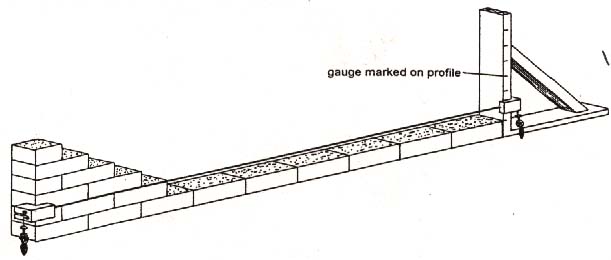
INFORMATION SHEET
PROJECT TITLE Project No; 1
Half Brick Wall in Stretcher Bond (Profile Assisted) CORE
1 of 5
Reasons for Bonding Brickwork
Bonding.
One of the main functions of a brick wall is to carry loads down to the foundations. This may be the load of the wall itself, which is called the ‘dead load’ or it may be loads that are carried by the wall, which are called ‘superimposed loads’.
Timber joists and roof trusses are classed as superimposed loads.
If the bricks are bedded one on top of the other as in Fig 1a, the load will only pass down a single stack of bricks.
If the wall is subjected to lateral pressure, it will simply push over a single stack of bricks.

 If the wall is bonded (Fig 1b), i.e. each course bedded with a half or a quarter brick lapped over, the course below the weight will be spread over a large area of wall.
If the wall is bonded (Fig 1b), i.e. each course bedded with a half or a quarter brick lapped over, the course below the weight will be spread over a large area of wall.
Bonding Terminology for Stretcher Bond
Bonding Terms.
See Fig 3a.
1. Half bat 2. Arris. 3. Perpend 4. Bed 5. Lap or half
bond 6. Stretcher face 7. Header face

Dry Bonding.
Dry bonding is the term given to laying the bricks without applying a bed or cross joint. This is done to establish the bond and size of cross joint required for a given dimension. (Fig 3b)

Securing Builders Line to Corners or Profiles.
Securing Lines.
When a wall exceeds five bricks in length it is good practice to use a bricklayers line to ensure correct line and alignment.
 When external corners or profiles are used the line can be secured using corner blocks. These are held in place by the tautness of the line. (See Fig 4a)
When external corners or profiles are used the line can be secured using corner blocks. These are held in place by the tautness of the line. (See Fig 4a)
Position of Line to Brickwork.
 When the brick is laid to the line it is important to ensure a ‘small gap is constantly maintained between the brick and the line’ to ensure the bricks do not foul the line. The brick is then laid with its top arris to the line and its bottom arris in line with the to arris of the course below. (See Fig 4b)
When the brick is laid to the line it is important to ensure a ‘small gap is constantly maintained between the brick and the line’ to ensure the bricks do not foul the line. The brick is then laid with its top arris to the line and its bottom arris in line with the to arris of the course below. (See Fig 4b)
Lay Out of Materials Prior to Building
Lay Out of Brick and Mortar Boards.
The positioning of material prior to laying is called ‘stacking out’ or ‘loading out’.
The material must be placed to ensure economy of movement for the bricklayer with everything in easy reach.
First a rough calculation of the bricks or blocks required should be carried out and the total number of bricks or blocks spread evenly along the wall in neat bonded stacks.
The stacks should be approximately 600mm from the face of the wall to give adequate working space. (See Fig 5)

Before mortar boards (spots) are loaded out with mortar they should be dampened to ensure they do not absorb the water from the mortar mix.
If this is not done the mix will be weakened and the workability of the mortar will be spoiled.
Transferring Levels with Straight-edge and Spirit Level
Transferring Levels.
The simple way to transfer levels over a short distance is by the use of a straight-edge and level
The straight-edge should be purpose made, having parallel sides and no curvature along its length. (See Fig 6a & b)

If the distance to be levelled is greater than the length of the straight edge, intermediate bricks will need to be bedded and levelled.

When this is carried out the straight edge and level should be reversed end to end to even out any inaccuracies there may be in the level or the straight edge.
